You know, it surprises me that out of all the instruments I have reviewed on this site, I haven't yet looked at a ukulele bass. I suppose there are not that many about if the truth be told, but they are becoming increasingly popular. I was therefore delighted to have this Kamoa E3E Bass ukulele sent to me on loan by the good folks at Southern Ukulele Store.
Confession first though. I am not a fan of ukulele basses. When I started on uke, there really was no such thing and then Kala came through with their U Bass models, the ones with the rubbery strings. I don't want to be controversial but I just don't like them. I just cannot get on with those thick, grippy strings that kind of twist on the fingertip and take an age to settle into tune. Don't get me wrong, in the right hands (and I am no bass player) they have a terrific woody sound, very like a double bass, but those strings and their low tension just niggle with me. But there is another reason too..... Why a 'ukulele' bass? A ukulele is the size it is because of its history and heritage. Its a ukulele, that is how they look! So why the drive to make a bass guitar smaller? Why does it need to match the ukulele on scale? At a gig of ours some time ago somebody said to me afterwards (having spied our full scale bass guitar) 'oh I suppose you 'get away with' playing a bass guitar because it has four strings?'.... I was lost for words.... Getting away with what?? Because we play ukes doesnt mean everything has to be miniaturised... We use a regular bass guitar because we like the sound. End of! As such I have always been confused as to why there is a U Bass market. But... there is, and it is growing, I just never felt compelled to join the clamour for one on account of THOSE STRINGS!
The Kamoa arrived though and I was extremely pleased. You see the E3E is a bass in every way, down to the fact it uses steel flat wound bass strings and not the rubbery ones. I was always led to believe that Kala went with the plastic strings to keep the tension down and therefore not destroy the uke, but Kamoa seem to have done it, and with more tension than a U Bass too! Let us take a closer look.
The Kamoa E3E is essentially a far eastern made baritone ukulele body with a wider bass neck stuck on to it. The body is in traditional figure of eight shape and is made from solid woods (spruce on the top and maple on the back and sides). The top is made from two pieces and is stained in red satin finish which just about allows the wood grain to show through. The sides are finished in a similar way and there are no flaws in the finish whatsoever making it feel very tactile if a little one dimensional. The top and back are joined to the sides with inner notched kerfing, and outer cream binding with some black white black trim. The back has a slight arch to it too. It all looks very clean though I think and goes together well.
The saddle (which appears to be NuBone or similar) sits in a rosewood bridge mount with a nice shape to it, and the strings are held by traditional acoustic guitar pins. I find pins fiddly on ukuleles but with this instrument using ball end bass guitar strings, tying knots in the 'ukulele way' would look a total mess. Aside from a small simple sound hole ring (a transfer) there is little other bling on the E3E at all.
The neck is wide to accommodate the extra string girth but is fairly shallow in profile. It is made from two pieces of maple with a joint at the heel and again is stained to match the body. The fingerboard is rosewood and appears to be edge bound (though that may just be darker stain) to hide the fret edges. It is a nice even piece of wood and holds 17 nickel silver frets with 12 to the body. One really nice thing to see is that the fretboard is 'radiused' meaning it has a very slight curve across the face to allow for easier playing, particularly with a wide fingerboard such as this. Edges of the rather chunky frets (this is a bass!) are very nicely finished and we have large pearloid fret markers at the 3rd, 5th, 7th, 9th and a double marker at the 12th. For the player there is a single small side marker at the 7th (well done Kamoa!).
Past the chunky dark wood nut (rosewood again I think) we have the standard Kamoa headstock shape. I do like it, and whilst it is still yet another crown shape it tapers from the base to the top and I think looks very classy. It is faced with what I think is rosewood with a small diamond Kamoa logo inlay in maple. All I would say is this headstock shows how nice a finish Kamoa can come up with but it kind of jars against the expanse of red on the rest of the instrument.
The tuners are unbranded metal sealed gears finished in black. Basically they are small ish bass guitar tuners and work just fine.
Finishing the package is an onboard active pickup system which is branded Kamoa but looks generic to me, perhaps a Belcat. It comes with volume, bass and treble faders and a low battery indicator and runs from a 9v battery. I am not much of a fan of these systems, but there you go. It is functional enough at this price.
So in short, it is a bass acoustic guitar in baritone uke size and retails in the UK for about £300. It is also designed to be tuned EADG like a regular bass but an octave up (same tuning as a U Bass, but the U Bass is the same as a regular bass guitar or double bass).
Testing it for play is not the easiest thing I can do as I am not a bass guitar player, but the thing that struck me first is that it is considerably louder unplugged than a Kala U Bass, and dare I say it, feels more solid and 'bassy' too. An acoustic bass is never going to be super loud, even at full scale guitar sized, but it sounds great for unplugged practice on account of those steel strings. Oh, and a pick makes it even louder!
The neck feels great in the hand and very much like a full scale bass to me. The setup arrived spot on with very little buzz (in my clumsy bass experience I always tend to create a bit of resonance buzz when I play one), but it is all nice and clear. Accurate across the neck too.
As I said above, the tuners work just fine. They are perhaps a little sloppy when starting to wind, but when in tune they hold just fine.
But it was the pickup I really wanted to try out and it works. I did find that strings 1 and 4 were a touch louder on this, with string 4 giving the uke an overly bass sound even without the bass fader anywhere high. This would just be a simple tweak to ensure the bottom of the saddle is seated properly and through a fuller bass rig I am not sure I would notice all that much. It doesn't sound anywhere as woody and thumpy as the Kala U Bass, and you may not like that, but these are steel strings so it is natural I guess. I do find it a lot brighter sounding than I would expect from a bass though and think that cheaper Piezo pickup has something to do with that as it sounds very 'electric' if that makes sense. A good pre amp or amp generally may well work wonders here.
Overall though it is very well put together and looks the part. I like the red colour I guess, but underneath it is actually a fairly plain ukulele and some more glamorous wood choices may have improved it I guess, as it looks a touch uninspired to me. As I say though, the build is great.
To me though it is really just a small acoustic bass guitar and the jury is still out for me as to why there is a need to call it a ukulele when it isn't... That isn't a criticism of the instrument itself, more of the uke bass fad - the instrument is a great little thing I think. If you are already a regular bass guitar player or a Kala player who doesn't get on with U Bass strings, these have got to be worth having a look at.
But it is the price that should really turn your head - £300 is on a par with the Kala Rumbler, and cheaper than other U Basses including the Ortega. Great great value in my view and a must see for anyone moving to the bass side!
Check out the video review below and then the scores on the doors!
PRO's
Price
Steel strings
Build quality
CON's
Cheap pickup system
Striking red finish but underwhelming woods underneath
VIDEO REVIEW
SCORES
Looks - 8
Fit and Finish - 9
Sound - 8
Value For Money - 9
OVERALL - 8.5 out of 10
To understand my review scoring and see this result in context - visit my review page at




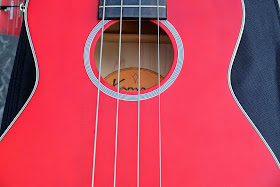
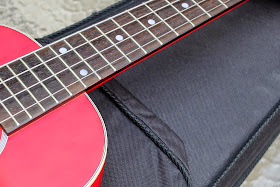
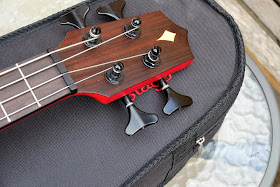


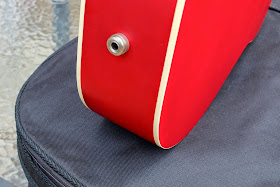
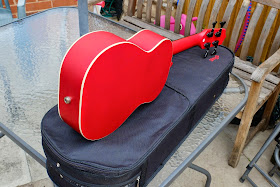
Major downside: it is tuned an octave above the double bass or bass guitar. The Kala is not. The Kala is tuned identically to the double bass. Sixteen-foot pitch.
ReplyDeleteyes, a fair point. Though I don't see it as a downside, major or otherwise. It has plenty of bass and the strings alone put it above the Kala for me (of course that is just my opinion)
ReplyDeleteI'd love to hear this hooked up to an octave pedal.
ReplyDeleteCould you downtune this to DGBE (or would the strings be too loose)? Then you'd have an "octave baritone" and not have to learn new fingering.
ReplyDeleteThis is exactly the issue. Easy transport quick set up musicians want those low woody bass sounds without lugging around a bass. The fact that this one cant hit the low bass means that it doesnt fullfill its mission.
ReplyDeleteDoesn't make it an invalid musical instrument though. I know a couple of ukulele bands that use one of these very effectively.
ReplyDeleteAnybody knows another kind of string for this bass, like pyramid silver or not metal string like the tipical u-bass strings?
ReplyDelete